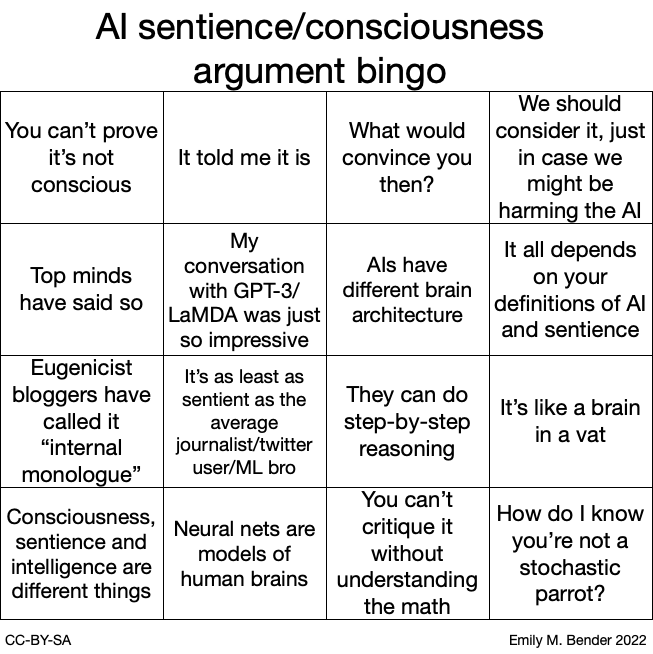Emily M. Bender? Timnit Gebru? Angelina McMillan-Major? Margaret Mitchell? Apocryphal?

Question for Quote Investigator: Artificial intelligence (AI) researchers have used vast amounts of text to train digital neural networks which capture the intricate statistical patterns of word sequences. The resultant systems are called large language models. One of the most famous is GPT-3 (Generative Pre-trained Transformer 3).
Language models (LMs) are able to perform a variety of tasks, e.g., answering questions, summarizing documents, generating text, and translating text. However, influential AI researchers believe these capabilities are misleading and often overestimated. Thus, these models should be considered merely “stochastic parrots”. Would you please help to find a citation?
Reply from Quote Investigator: In March 2021 Emily M. Bender, Timnit Gebru, Angelina McMillan-Major, and Margaret Mitchell (who used the pseudonym Shmargaret Shmitchell) published “On the Dangers of Stochastic Parrots: Can Language Models Be Too Big?🦜” which critically examined recent research efforts. The title included a parrot emoji. Boldface added to excerpts by QI:1
Contrary to how it may seem when we observe its output, an LM is a system for haphazardly stitching together sequences of linguistic forms it has observed in its vast training data, according to probabilistic information about how they combine, but without any reference to meaning: a stochastic parrot.
On October 8, 2021 QI sent a tweet to authors Emily M. Bender and Timnit Gebru asking about the coinage of the memorable phrase “stochastic parrot”. Gebru gave credit to Bender,2 and Bender concurred:3
Yep, that was me. As it happens, I did a search when the paper was under review and before Google made a news story out of it, to see if it had been used online before then, and wasn’t able to find any instances.
Bender is a Professor of Linguistics at the University of Washington in Seattle, Washington.
Below are additional selected citations in chronological order.
In April 2022 journalist Steven Johnson of “The New York Times” published “The Writing on the Wall” which reviewed recent AI research:4
In a much-discussed paper published last year, the University of Washington linguistics professor Emily M. Bender, the ex-Google researcher Timnit Gebru and a group of co-authors declared that large language models were just “stochastic parrots”: that is, the software was using randomization to merely remix human-authored sentences. “What has changed isn’t some step over a threshold toward ‘A.I.,’” Bender told me recently over email.
Johnson expressed uncertainty about the value of large language models:
If, in fact, the large language models are already displaying some kind of emergent intelligence, it might even suggest a path forward toward true artificial general intelligence. But if the large language models are ultimately just “stochastic parrots,” then A.G.I. retreats once again to the distant horizon — and we risk as a society directing too many resources, both monetary and intellectual, in pursuit of a false oracle.
In June 2022 Emily M. Bender tweeted a picture of a 4×4 grid representing a bingo card together with this message:5
For those playing along at home, here’s a “AI is sentient!” argument bingo card.

The slot in the lower right said the following:
How do I know you’re not a stochastic parrot?
In conclusion, the earliest instance of “stochastic parrot” known to QI appeared in the academic article “On the Dangers of Stochastic Parrots: Can Language Models Be Too Big?🦜”. QI believes that Emily M. Bender deserves credit for coining the expression “stochastic parrot” based on her claim in a tweet dated October 8, 2022.
Image Notes: A parrot constructed using triangles to illustrate the notion of a stochastic parrot.
Update History: On October 8, 2022 the information tweeted by Emily M. Bender and Timnit Gebru on October 8, 2022 was added to the article. The conclusion was rewritten. Also, the parrot emoji was added to the title of the March 2021 article. On March 14, 2025 the format of the bibliographical notes was updated.
- Article: On the Dangers of Stochastic Parrots: Can Language Models Be Too Big?, Authors: Emily M. Bender, Timnit Gebru, Angelina McMillan-Major, and Shmargaret Shmitchell, Conference: FAccT ’21, (FAccT is an acronym for the ACM Conference on Fairness, Accountability, and Transparency), Date: March 3–10, 2021, Quote Page 616 and 617, Location: Virtual Event, Canada. link ↩︎
- Tweet, From: Timnit Gebru @timnitGebru, Time: 12:49 PM EDT, Date: Oct 8, 2022, Text: Emily did. (Accessed on twitter.com on Oct 8, 2022) link ↩︎
- Tweet, From: Emily M. Bender @emilymbender, Time: 3:27 PM EDT, Date: Oct 8, 2022, Text: Yep, that was me. As it happens … (Accessed on twitter.com on Oct 8, 2022) link ↩︎
- 2022 April 17, Section: New York Times Magazine, The Writing on the Wall by Steven Johnson, Start Page 28, Quote Page 34, Column 2, New York. (ProQuest) ↩︎
- Tweet, From: Emily M. Bender @emilymbender, Time: 12:07 AM, Date: Jun 13, 2022, Text: For those playing along at home … (Accessed on twitter.com on October 6, 2022) link ↩︎